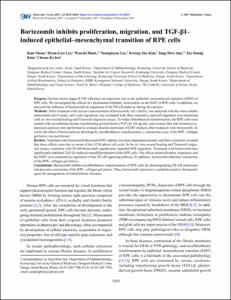Bortezomib inhibits proliferation, migration, and TGF-β1-induced epithelial-mesenchymal transition of RPE cells
- Keimyung Author(s)
- Baek, Won Ki; Kim, Kwang Soo; Jun, Jong Hwa
- Department
- Dept. of Microbiology (미생물학)
Dept. of Ophthalmology (안과학)
Institute for Cancer Research (암연구소)
- Journal Title
- Molecular Vision
- Issued Date
- 2017
- Volume
- 23
- Issue
- 12
- Abstract
- Purpose :
Nuclear factor kappa B (NF-κB) plays an important role in the epithelial–mesenchymal transition (EMT) of RPE cells. We investigated the effects of a proteasome inhibitor, bortezomib, on the EMT in RPE cells. In addition, we assessed the influence of bortezomib on regulation of the NF-κB pathway during this process.
Methods :
After treatment with various concentrations of bortezomib, cell viability was analyzed with the water-soluble tetrazolium salt-8 assay, cell-cycle regulation was evaluated with flow cytometry, and cell migration was monitored with in vitro wound healing and Transwell migration assays. To induce fibroblastoid transformation, the RPE cells were treated with recombinant human transforming growth factor (TGF)-β1 (10 ng/ml), and western blot and immunocytochemical analyses were performed to evaluate altered expression of EMT markers after treatment with bortezomib. To verify the effect of bortezomib on shrinkage by myofibroblastic transformation, a contraction assay of the RPE–collagen gel lattice was performed.
Results :
Treatment with bortezomib decreased RPE viability in a dose-dependent manner, and flow cytometry revealed that these effects were due to arrest of the G2/M phase cell-cycle. In the in vitro wound healing and Transwell migration assays, treatment with 20 nM bortezomib significantly impeded RPE migration. Treatment with bortezomib also significantly inhibited TGF-β1-induced transdifferentiation of the RPE cells. The effects on proliferation, migration, and the EMT were mediated by regulation of the NF-κB signaling pathway. In addition, bortezomib inhibited contraction of the RPE–collagen gel lattices.
Conclusions:
Bortezomib inhibits myofibroblastic transformation of RPE cells by downregulating NF-κB expression and prevents contraction of the RPE–collagen gel matrix. Thus, bortezomib represents a candidate putative therapeutic agent for management of retinal fibrotic diseases.
- Publisher
- School of Medicine (의과대학)
- Citation
- Kun Moon et al. (2017). Bortezomib inhibits proliferation, migration, and TGF-β1-induced epithelial-mesenchymal transition of RPE cells. Molecular Vision, 23(12), 1029–1038.
- Type
- Article
- ISSN
- 1090-0535
- 파일 목록
-
-
Download
 oak-2018-0170.pdf
기타 데이터 / 6.58 MB / Adobe PDF
oak-2018-0170.pdf
기타 데이터 / 6.58 MB / Adobe PDF
-
Items in Repository are protected by copyright, with all rights reserved, unless otherwise indicated.